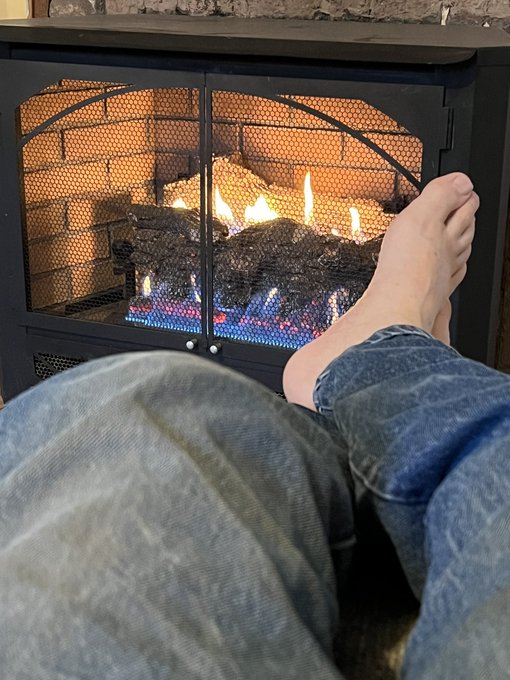 On Friday, March 3rd, a severe windstorm blew through the Bluegrass State. There was some serious damage in several places, but though we had some pretty high winds near where I live, our farm suffered no damage at all. The road leading to our farm saw some trees downed, and one of the parishioners at our church said that her son had seen the roof blown off of his farm equipment storage shed, but, overall, it wasn’t too bad for us.
On Friday, March 3rd, a severe windstorm blew through the Bluegrass State. There was some serious damage in several places, but though we had some pretty high winds near where I live, our farm suffered no damage at all. The road leading to our farm saw some trees downed, and one of the parishioners at our church said that her son had seen the roof blown off of his farm equipment storage shed, but, overall, it wasn’t too bad for us.
Then I saw the tweet screen captured on the right.
We didn’t lose power at the farm. It flickered a time or two, but that was it. We did lose the internet for about half an hour.
When I saw Evelyn Schultz’s tweet, I figured that I’d get a more detailed story from what my best friend used to call the Lexington Herald-Liberal, so I went to their website. Following a real belly-laugh at the website opening, in which a daily, except for Saturday, newspaper had a heading which still said it was March 3rd, which I screen captured here at 8:10 AM EST on Monday, March 6th, I found this one:
Updated: Major power outages persist across Kentucky. KU explains long Lexington outages
By Taylor Six | Sunday, March 5, 2023 | 9:05 PM EST
More than 100,000 customers throughout Kentucky were still without power Sunday evening as a result of a Friday windstorm – which one power company labeled as the third most damaging weather event in 20 years for their services.
According to the Kentucky Utilities website, Friday’s weather impacted more than 300,000 customers across their service area and brought down 2,500 power lines. It also broke more than 230 utility poles. This windstorm ranks behind the 2009 ice storm and the 2008 windstorm in terms of the number of customers affected and total system impact.
“We have every resource responding to this event, including an additional 1,500 resources from other utilities,” KU said on its website.
As of 10:30 a.m. Sunday, 70,000 KU & LGE customers were still without power statewide, according to Daniel Lowry, a spokesman for KU. In Lexington, he said about 38,000 were still without power.
Read more here.
As I have mentioned several times previously, electricity is our most vulnerable-to-the-weather utility. Water, sewer and natural gas utilities are run through underground pipes, but electricity is delivered via overhead wires. Even in the newer subdivisions in which electric lines are buried, power comes to substations via overhead wires.
Now, it’s not that cold this morning; my weather station told me that it was 38.8º Fahrenheit at 8:00 this morning, but it was slightly below freezing yesterday, at 30.1º F. I’m guessing that by Sunday morning, the people without power and who depended on electric water heaters, weren’t able to enjoy hot showers in the morning, weren’t able to have a hot breakfast if they had an electric range, and were pretty heavily bundled up in their own homes if they depend on electricity for heat. That, after all, happened to me in early March of 2018,[1]Working from memory, I have previously said that it was January of 2018, but I recently looked at my 2018 diary, and found out that it was actually March 12-15, 2018. when the sparktricity failed for 4½ days following a heavy snow-and-ice storm. Since we were remodeling anyway, we added a propane range, water heater, and fireplace, so if the power fails again, we’ll still have heat, hot water, and cooked meals.But remember: the Biden Administration wants people to get rid of natural gas utilities and depend exclusively on electricity, all to fight global warming climate change!
It’s March, and with the arrival of meteorological spring, temperatures aren’t bitterly cold in the Bluegrass State. But winter weather is still persisting in large parts of the United States, in the inland west, the northern midwest, and New England. people in those regions, when the power fails, can face life-threatening conditions. More, it isn’t always spring when the power is down; it can happen at any time, including the depths of winter. What the climate activists want is for people to just plain die, because that would be the result of a multi-day power outage in upstate New York or Minnesota or Denver if the left get their way. The truth is simple: they really don’t give a damn about the people!
References
| ↑1 | Working from memory, I have previously said that it was January of 2018, but I recently looked at my 2018 diary, and found out that it was actually March 12-15, 2018. |
|---|




 Somehow, one of the French doors, which are on the northwest-facing wall, blew open overnight. The heat pump couldn’t keep up with an open door during January, but the propane stove came on as well — it has a separate, battery-powered thermostat — and that kept the house reasonably warm.
Somehow, one of the French doors, which are on the northwest-facing wall, blew open overnight. The heat pump couldn’t keep up with an open door during January, but the propane stove came on as well — it has a separate, battery-powered thermostat — and that kept the house reasonably warm.